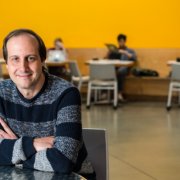Inaugural director of The Quest discusses what's been accomplished since last spring's launch and what is on the horizon.
It’s hard to name a field that artificial intelligence hasn’t impacted already. From mobile devices with facial recognition to self-driving cars, we are still experiencing waves of innovative technology that can be traced back to major breakthroughs in our understanding of intelligence, like machine learning. But the truth is, many of these breakthroughs driving current machine intelligence technology are actually decades old. So what’s next for the future of intelligence?
Building on a rich history of innovation and impact in the field of intelligence, MIT launched The Quest for Intelligence (The Quest) last spring. Comprised of two linked entities, The Core and The Bridge, The Quest aims to advance two fundamental intelligence challenges: Can we reverse engineer intelligence? And, how can we deploy our current and expanding understanding of intelligence to the benefit of society? Antonio Torralba, the inaugural director of The Quest, recently spoke on what he and his colleagues have been working on since the launch last spring. He describes how The Quest Core and The Quest Bridge will work together to advance our understanding of intelligence, and shares how others can join The Quest.
Q: What has The Quest been up to since it launched last spring?
A: It’s been a busy summer for The Quest! I’m proud of the leadership team we’ve assemble, and we've been working together to formalize our vision for the future of our efforts to support intelligence research and translation at MIT. We’ve also spent quite a bit of time doing outreach around campus to get a better sense of our own community’s interests and needs. We’ve discovered that there are so many people — across all five schools — who are interested in the topic of intelligence and how it can improve their respective field. It’s been exciting to create those connections with research groups you haven’t interacted with before...
Read the full article on the MIT News website using the link below.

